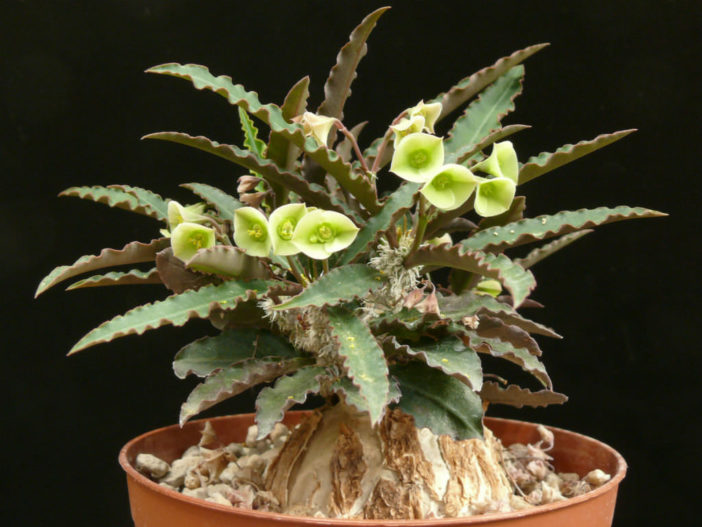Scientific Name
Euphorbia suzannae-marnierae Rauh & Petignat
Scientific Classification
Family: Euphorbiaceae
Subfamily: Euphorbioideae
Tribe: Euphorbieae
Subtribe: Euphorbiinae
Genus: Euphorbia
Etymology
The specific epithet "suzannae-marnierae (soo-SAN-ay-ee mar-nee-AIR-ay-ee)" honors Suzanne Marnier-Lapostolle, second wife of the French botanist and explorer Julien Marnier-Lapostolle (1902-1976).
Origin
Euphorbia suzannae-marnierae is native to southeast Madagascar. It grows in dry deciduous forests.
Description
Euphorbia suzannae-marnierae is a small succulent that forms a spherical or egg-shaped, quite rough caudex topped with a few, usually erect branches with spirally arranged leaves at the apex of the branches. It grows up to 10 inches (25 cm) tall. The caudex is grey-brown and up to 2 inches (5 cm) in diameter. The branches are cylindrical, branching at or near the base, up to 8 inches (20 cm) long, and up to 0.4 inches (1 cm) in diameter. Leaves dark green with a grayish or purplish underside. They are lance-shaped or elliptic with wavy margins, up to 2 inches (5 cm) long, and up to 0.4 inches (1 cm) wide.
The flowers are bell-shaped, greenish-pink, and appear in clusters of 2 to 8 on up to 1.2 inches (3 cm) long stalks.

Hardiness
USDA hardiness zones 10b to 11b: from 35 °F (+1.7 °C) to 50 °F (+10 °C).
How to Grow and Care
Euphorbias are very easy to care for. These plants require a little pampering to become established, but once they are, they are self-sufficient. In fact, more die from too much care and watering than from neglect. Euphorbias need well-draining soil and lots of sunlight. They are not particular about soil pH but cannot tolerate wet soil. Unlike most succulents, Euphorbia does not handle long periods of drought well. It may need weekly watering during the summer. Water whenever the soil is dry several inches below the surface. Water deeply, but don't let them sit in wet soil, which can cause root rot. Add some organic matter or fertilizer to the planting hole. Feed with a half-strength fertilizer monthly if you are growing them in containers or your soil is poor.
These succulents can be grown from seed, but they can be difficult to germinate (or even find). They are usually propagated by cuttings. This can be tricky because of the exuding sap. Rooting hormone is recommended with Euphorbias. They tend to grow problem-free, but there are a few pests and diseases to be alert for.
Learn more at How to Grow and Care for Euphorbia.
Links
- Back to genus Euphorbia
- Succupedia: Browse succulents by Scientific Name, Common Name, Genus, Family, USDA Hardiness Zone, Origin, or cacti by Genus
Photo Gallery
Click on a photo to see a larger version.



